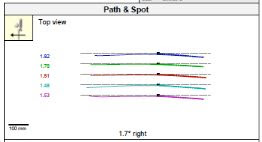Over the course of golf history there have been several
iconic putter designs. But none have been replicated more than the Ping Anser
and Anser 2 model. Every putter maker from boutique to major manufacturer has a
version of these designs in their product mix. As more than one industry
insider has told me, “You have to have one.” To give credit where credit is due,
Thanks to Tiger Woods, I firmly believe this model is the best-selling design
type of all time.
Even with the vast number of different designers offering
their version of the design to the public, the basics remain the same. Full offset
neck, often referred to a mechanical or “plumbers” neck, moderate 45 degrees of
toe hang along with the iconic heel and toe weighting. The toe hang might vary
depending on the designer’s choice of neck and blade length, but normally within
the parameters of what would be required by a moderate arc.
One of the things we found surprising as we started to match
successful strategies to this putter, is that while it is by far the most
common choice of design it is in no way the most versatile. The most successful
strokes, when measured are specific when you look at the averages. Path one – two
degrees right for a right-handed golfer and face less than one degree closed at
impact. You might be thinking, these are successful numbers for any putter, but
the measurements of the successful users of this model all had these tendencies.
In our system this is a Profile 4.
One dominant tendency we saw in the measurements is for the
putter to swing in a closed position relative to the path. Two potential reasons. First there is a tendency for right eye dominant players to aim the line in the cavity left. We like to start with no line. Personally, I think it is a function of the plumber’s neck. Byron Morgan has built many putters
for my clients with the same offset and toe hang, and we did not see the same closed
to the path tendency. Could be look, could be feel, but the stats are straight
forward. In fact, we have seen the same
closed to path tendencies in mallets with a plumber’s neck as well.
 |
| Top Ten World Ranking Profile 4 |
When we measured players prior to the Tiger Woods phenomenon,
we saw a number of strokes in the Profile 3 and 6 categories. Arc’s that swung
straight back on the back-swing and followed the plane to finish left on the
follow through. Some used the Anser/Newport but with the ball much farther back
in the stance to compensate for the closed face. They found the earlier impact is in the
arc the less closed the face to the target line. Then two things happened. Instructors
started to recommend a ball forward position to allow you to hit up on the
ball, with the hope of producing a better roll. But in my mind, it was Tiger
describing his stroke as a high hook that turned the tide. Ball forward, arc
tilted right, Newport design. Please remember that even though the arc is tilted to the right, because of the arc in the stroke, the path direction maybe perfect
at impact. But the probability of the face being slightly closed to the target line
are better than good. So fr many the more you tilt the arc the more likely you are to be sqaure at impact.
 |
| Profile 6 Straight Back to Left |
In our other reviews, I have given you other Profile options.
The Anser/Newport is not that versatile. The putter gets too shut in the back
swing for a Profile 1, forcing a block push release. In the Profile 7, it can
be hard to rotate enough. Open face at impact. In all the other profiles there
are several manipulations required to get it to work. In these instances you
see similar head shapes, but with modified necks. Or more common a player who struggles
to find consistency. Don’t fight it. Use Profile 4.


No comments:
Post a Comment